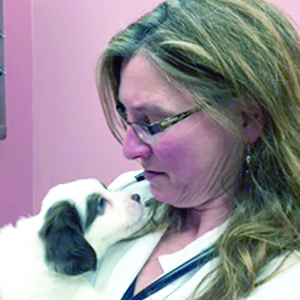
Episode 55
Tech Support, Part III: Searching for Solutions
Tackling the Technician Shortage Series See All Episodes »
What is behind the widespread shortage of technicians, and what can be done to reverse it? It’s a complicated question many organizations are asking but no one has yet been able to answer. In 2021, OVMA established a task force to investigate this worsening trend, and in the past year, it has dug deep into the root of the problem in an effort to better understand its complexities and identify potential solutions.
In the pilot episode of Fully Vetted’s Tackling the Technician Shortage Series, we met Dr. Diana Cron, technician Kelley Norris, and Dr. Jennifer Wells of OVMA’s Technician Recruitment & Retention Task Force. They offered a brief history of the technician shortage, explored the factors that laid the groundwork, and discussed how the profession as a whole has been impacted.
In the second installment, we explored three different perspectives on the same issue—those of the veterinary technician, the practice owner, and the educator—and discussed the task force’s recent survey of Ohio veterinarians and technicians.
In this, the final episode of the series, we look at the current state of technician education and training; ideas for the future; and ways veterinarians and practice owners can improve the technician experience to keep them happy, healthy, and employed.
Episode Guests

Diana Cron
DVM
Dr. Cron serves on the OVMA Board of Directors and is co-owner of Glenway Animal Hospital in Cincinnati.
Learn More »

Kelley Norris
RVT
Kelley is the assistant director of companion animal patient care at OSU Veterinary Medical Center.
Learn More »

Jennifer Wells
DVM
A former technician, Dr. Wells is the program director of the University of Cincinnati Blue Ash Veterinary Technology Program.
Learn More »
Transcript
Krysten Bennett: Today we’re wrapping up our Tackling the Technician Shortage Series. In case you haven’t been binging this series, I’d like to re-introduce you to our panelists: First we have Dr. Diana Cron, co-owner of Glenway Animal Hospital in Cincinnati. Next is Kelly Norris, RVT, who is the assistant director of companion animal patient care at OSU Veterinary Medical Center. And finally, Dr. Jennifer Wells, who is the program director of the UC Blue Ash veterinary technology program as well as a former technician.
To refresh your memories, in our last episode, we talked about some of the reasons why technicians are leaving veterinary practices or even the profession altogether. We ended the conversation with a few ideas of how practice owners can mitigate that, including financial support for assistants who want to go on to become RVTs — which is the perfect segue into my next question.
Some of the veterinarian comments submitted in the survey indicated technicians were not adequately prepared to work in the profession. Dr. Wells, as you mentioned, you are the veterinary technology program director at UC Blue Ash. What do you think think has happened or not happened at the academic level to contribute to this problem?
Jennifer Wells: I think there’s probably a variety of potential causes for that type of comment. And because all the comments weren’t released to the public, I want to just say that I think that was only one comment out of, you know, hundreds of comments. So it’s not, I don’t think, a widely held belief, but I’m happy to talk to anyone that has a strong belief about that.
First off, our job in veterinary technology education is to graduate entry-level technicians. And so we are required by the AVMA to have them demonstrate to us, either in the classroom or physically on an animal, over 300 skills—a huge task to do in a year or two years, depending on the type of program that you’re in. And so we are just getting them to the point where they’ve seen it before and they’ve practiced it. We have acknowledged that they’ve practiced it appropriately. They’re doing it correctly, but they haven’t practiced it 50 times. They haven’t done it over and over and over again. They learn more in the first six months to a year after graduation than they ever learn from us. We give them the baseline that they can then apply when they get their first job and to pass the board exam, which they do usually within a few months of graduation.
I think the other part that is sometimes problematic is that when we have students that have never worked in practice before, often when they graduate, they may have that technical skill, they may have worked with an instructor in a clinic and talked to clients or modeled communication behaviors. But oftentimes we see that they are underprepared for actually communicating to clients. And you see that when you hire anybody into practice, it takes some time for them to become comfortable with how to explain medical conditions or treatments to an owner. And so I think that probably comes out in this area as well, that they just need practice and support and mentoring to get better. I can guarantee, the AVMA can guarantee, that we’ve met those minimums that are required of us, but they need support and mentoring to get better.
KB: Do you think that those veterinarians that hold that belief aren’t aware of what technicians are taught in school, or maybe their expectations are higher than they should be?
JW: Yeah, I think that’s a possibility. I would certainly encourage any veterinarian who has questions about what is taught, please come sit on our advisory board. All of us in any vet tech program in Ohio or another state, we are required by the AVMA to have an advisory board, and we love to get opinions. What I hate on my advisory boards is when I sit there and just update you on everything that’s going on, and I get no feedback. We love to have opinions about what you’re seeing in the profession, what you’re seeing from our graduates, and what you’re seeing from other graduates that maybe are better than ours and something that we can improve upon. And so any vet tech program is going to be happy to have that participation. So that’s kind of step number one.
I think that it’s possible that they may have different expectations depending on what types of graduates they’ve worked with before. Certainly we have graduates, and we surveyed them again this year, 85 percent of our graduates were working in practice before they graduated. So they had already had a job, usually as an assistant, and so they were already practicing their skills. They were learning the computer system at that practice. And so when they graduated, it looks like, wow, this is an RVT that’s ready to go, because they’d already been in that practice before.
And as I said before, that’s a great way to get more RVTs. Help them through school, support them with their school schedules, help mentor them as they’re learning their techniques as they’re going through school, and then keep them once they graduate. Obviously, sometimes that’s the harder part too.
But I think if you’ve had that experience before and then you get a student who comes out of school who has not worked in a practice before—we do have students that are coming from other professions, and maybe they’ve never worked in a practice other than the minimum that we require for their entrance into the program. They do not have that concept. And so there’s a steep learning curve for those students that have never lived the day to day in a veterinary practice. Some students are going to take more mentorship to try to get up to that level, even though they have demonstrated they’ve practiced those very entry-level skills.
Kelley Norris: Yeah, they absolutely do. And it doesn’t even depend on which program that they’ve gone to. It depends a lot on the initiative of that particular student. There are certainly some students who are go-getters who have worked in private practice before, and they’re ready to go right when they graduate from technician school. There are others that graduate and don’t have any self-confidence and need to have their hands held for a while before they’re ready to tackle some things on their own. It is a little bit different here (at OSU), because it’s kind of a big, scary place initially for people. So certainly the more experience that they’ve had, even just being around a veterinary practice, the easier it is for those people.
But we have two students that we recently hired as assistants before they even pass their boards, just straight from school, and they could only do limited things while they were waiting to pass their boards and receive their license. But they spent those few months in the service where they were going to work and got an idea of how the routine went. And so the first day that they got their license, they’ve been in that service for a few months and they were ready to hit the ground running. It’s one of our more challenging services where they’re working. And it’s because the whole time that they were working as assistants, they were working on plans and what they would do and how they would have approached this differently once they were a registered technician. So certainly the individual’s personalities also make a difference, I think.
I also say that we run into similar circumstances as far as expectations with some of our veterinary students. They also need different amounts of mentoring when they get out into practice. They’ve all had the same amount of training and the same types of training, even the same specialty training in all of the different branches of veterinary medicine. And some of them are more prepared than others just because of who they are.
JW: We also asked a question (in the survey) about how many veterinarians and practices have implemented specific training protocols, especially for new employees. And that can certainly help if there is a specific training plan for the first four to six months that you come out. I know the corporate practices are great at this, but I think there are some nuggets that a lot of smaller practices could take from that, because you really can’t expect somebody to come in that first day and understand the way you do things or the way vet A does something versus vet B. There’s a lot of learning that takes place, even if you have some technical skills, as Kelley said. And so having those training protocols and plans in place, where they’re going to be mentored and they’re going to be demonstrating those skills, and as they demonstrate that they can handle that certain level of responsibility, they get more and more responsibility and move up and maybe get paid more related to that. So I think those are all important as well.
KN: And one of the things that we do at the university is the supervisors have weekly meetings with each new employee and then formal evaluations at certain time periods, where they go over the goals that they had made at the time period before and then how far they’ve come as far as achieving those goals and then creating new goals. That goes over the first six months that they periodically meet to review their goals and establish new goals moving forward.
KB: That would be a really great resource for some of the smaller practices to have. And I’m kind of jumping ahead here, but has the task force considered putting together some kind of training document as part of your plans?
Diana Cron: We haven’t talked specifically about doing that, but I think that would certainly be something that may be on our future list of suggestions to make to practices to help alleviate the problem.
I think the training piece and mentorship piece is huge. I agree with Kelley: If you try to hire a new graduate veterinarian, you run into the same problems. They just need more experience, and they have to be trained to fit your practice, too, because it’s just not a one-shoe-fits-all type of thing. That’s something that the task force has not yet talked about specifically implementing, but we have talked about it as being important, because that is one of the things that technicians said that was important to them, for them to have some kind of a training program, an opportunity to continue to learn more new things.
Mia Cunningham: So what else has the group talked about in terms of what to do with information gleaned in the survey? How do you all plan on moving forward?
DC: This problem is so multifaceted, so we tried to divide it up into utilization and retention, and then attraction of more people to the field. It’s two separate but interconnected issues, and we are going to be putting together some pieces—articles and things like that—with some specific suggestions on how practices can keep their technicians happier. And I was talking with Jack Advent, our executive director, and he said it’s a little bit like talking about climate change, because there’s so many different people involved and there’s so many people that are stakeholders, and then there’s the naysayers and the people that want the problem fixed right now. But essentially, it just takes time and awareness of the problem and everybody working together in order to try to make a difference.
JW: Yeah, I think getting resources is the most important thing. The survey has already been published, but those (results) can be reiterated, as we’ve done in this podcast, but also in other avenues. We talked about highlighting highly performing technicians—what they’ve done, how they’ve furthered their education, things like that—potentially in social media. And then other things that I already mentioned, like what I consider low-hanging fruit: Making sure that your technicians are recognized as such. You don’t dress your staff all in the same colored scrubs. You make sure that their scrubs say that they’re registered veterinary technicians. Put some sort of a poster on the wall about what the job duties of a technician are versus other people in the clinic.
There’s a lot of what I would consider pretty easy things to do to highlight the wonderful work that our technicians do and educate the public on that as well, because they’re an important key component to supporting that. They want technicians doing dentals on their dogs. They don’t want assistants illegally doing anesthesia and dental on their dogs. So I think those are all important points.
KB: So while you guys are out there figuring out all the answers to this problem, are there any resources that we can include in the show notes to help our listeners navigate this problem?
DC: The full survey is on the OVMA website for anybody that wants to access that.
KN: And the OVMA puts out a very nice list of tasks that technicians are legally allowed to do and tasks that veterinary assistants are legally allowed to do. And it’s something that is a really good comparison tool for practice owners and administration.
MC: Did you ladies have any final thoughts? Anything else you’d like to share before we let you go?
JW: I would just kind of keep reiterating (that veterinary professionals continue) trying to encourage more people to come into the profession, both hiring assistants and mentoring them into higher-performing roles, but also encouraging them to go on to school if it’s appropriate for them. Again, we’ve heard that a lot of people are subsidizing the cost of education, which can be a barrier for many of our students. I think that’s a real benefit that may help if they can’t pay them a lot more. Certainly paying for some of their education can be really helpful.
As we’ve talked about, this is nothing new. The climate is changing. The number of animals we’re trying to take care of is changing. But this problem of having enough technicians is not changing. And so we can’t ignore it. It’s only getting worse. We have to do something. I mean, every practice has to do something. We have to educate our veterinarians on how to utilize technicians better. We have to get more technicians into school and then work our hardest to keep the technicians that we do have in the profession.
DC: We would welcome anybody’s input. If anybody wants to be on the task force, please contact me or (staff liaison) Mia Cunningham, and our email addresses will be in the program links.
MC: Absolutely.
KB: We’ll have to have you back on once you figure everything out. Right?
JW: We’ll be millionaires if we can figure this problem out!
DC: We’ll have to patent it.
KB: You’ll win a Nobel Prize, too.
JW: We can hope!
KB: Lofty goals.
JW: Yeah, exactly.
MC: Well, thank you, ladies. Enjoy the rest of your afternoon!



